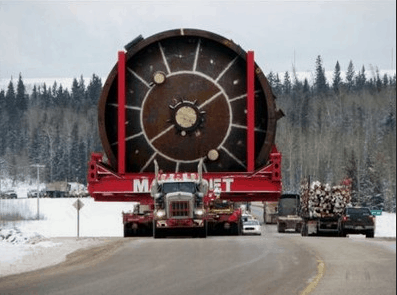
According to the Missoulian U.S. District Judge B. Lynn Winmill has sided with environmentalists and ruled the U.S. Forest Service erred by not exercising its regulatory authority when Idaho allowed huge trucks to haul giant oil refinery equipment along U.S. Highway 12, through a scenic corridor protected by the 1968 Wild and Scenic Rivers Act.
The group, Idaho Rivers United, sued the government in 2011 after the state allowed ExxonMobil’s Canadian unit to ship hundreds of so-called megaloads from Idaho’s Port of Lewiston along the two-lane highway. A copy of the judge’s ruling is here.
A previous article contained this additional information:
Idaho Rivers United argues the U.S. Forest Service neglected its duty to intervene, including by allowing 500 trees along U.S. Highway 12 to be trimmed to accommodate oil-gear shipments by ExxonMobil weighing up to 300 tons. The federal agency says it relinquished that authority over the shipments between Lewiston and the Kearl Oil Sands projects in southern Alberta to the state of Idaho….
As early as September 2010, Forest Service leaders in Idaho expressed concern about the ExxonMobil shipments. That month, Clearwater-Nez Perce National Forest supervisor Rick Brazell told the Idaho Transportation Department in a letter that hundreds of oversized loads jeopardize “the experience the traveling and recreating public will have along U.S. Highway 12 through the introduction of overtly industrial elements into the otherwise pastoral environment.”
In the same letter, however, Brazell conceded he was powerless to interfere. “I recognize that I have no jurisdiction to stop these shipments, but I do oppose the idea of allowing this precedent to be set,” he wrote.
For more information about this issue, check out this video produced by some friends.
Monday AM Update: There have been some questions in the comments regarding what the Forest Service’s regulatory authority is in this issue. Here’s a portion of what the judge wrote:
“This line of authority – beginning with the Property Clause and proceeding through the Organic Act, the Federal-Aid Highways Act, the Wild and Scenic Rivers Act, and finally the Highway Easement’s directive to protect the scenic and esthetic values of the river corridor – is focused on granting the federal defendants the authority to regulate the use of roads over federal land. This authority clearly gives the federal defendants jurisdiction to review ITD’s approval of mega-load permits that authorize acts along the river corridor including the construction of turnouts along the rivers, the trimming of hundreds of trees, and the restriction of the public’s recreational opportunities.”